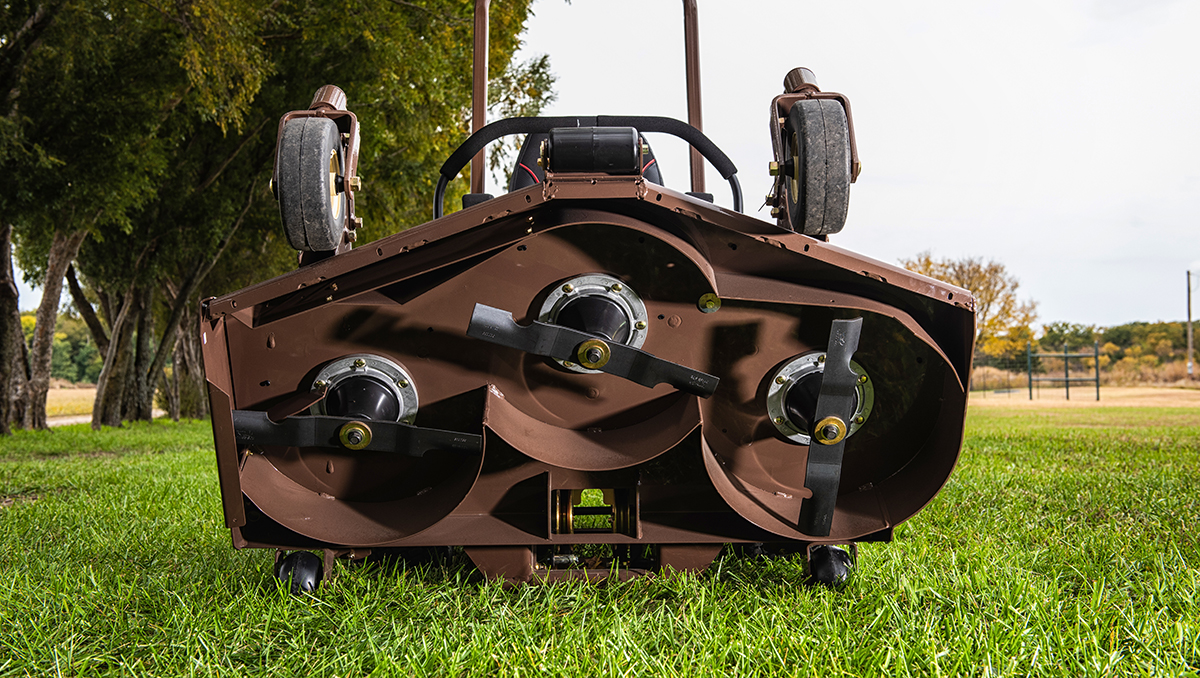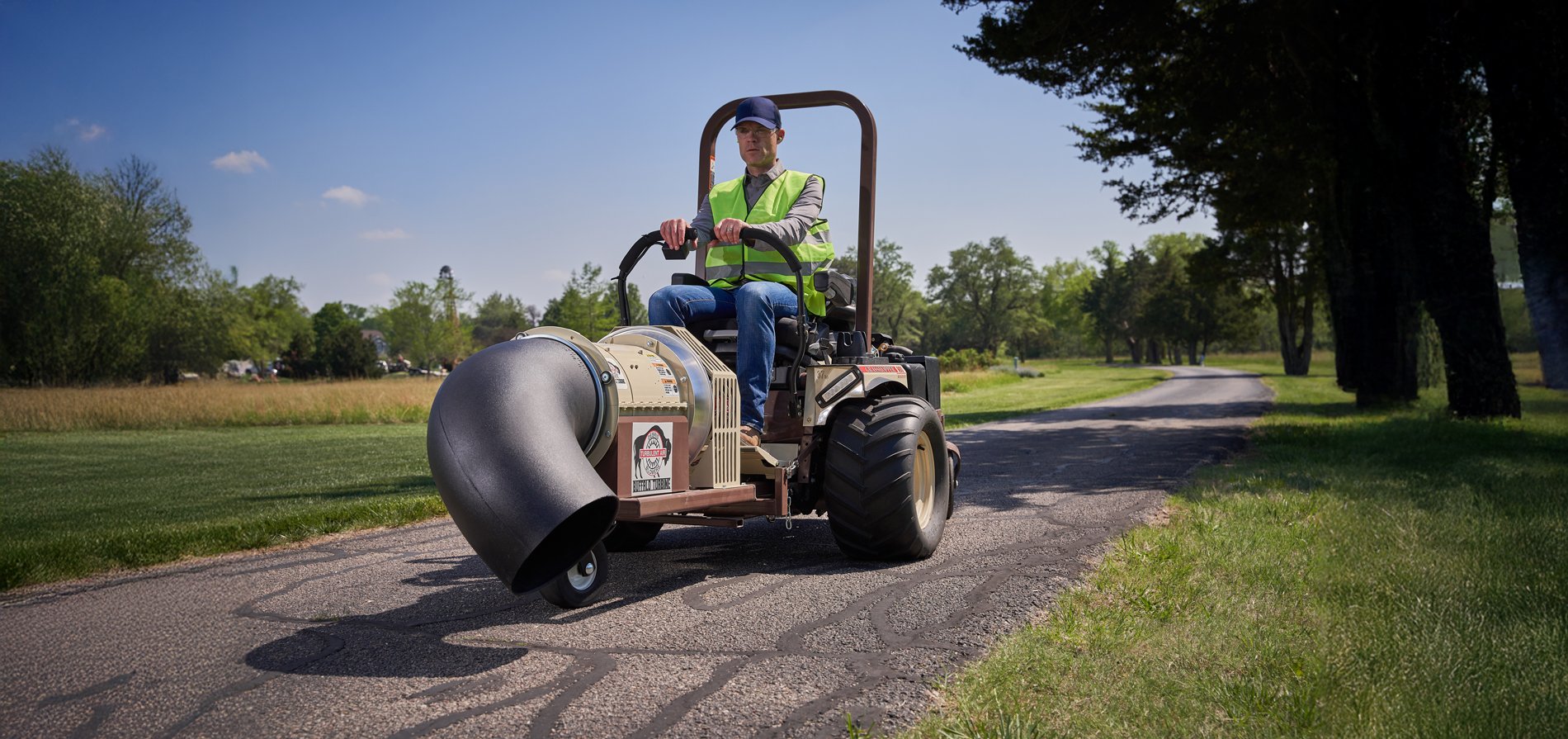They may seem like very different applications, but parks and roadsides share a lot of similarities when it comes to mowing. Both are typically big jobs that require a lot of manhours. Both are in sensitive areas that create additional safety considerations. On many occasions, the grass has become overgrown before your crew is able to tend to it. Yet, on some occasions, you still want your crew to leave a nice finished appearance when they finish mowing.
When determining how to best equip a crew to handle these types of challenges, there are several key factors that should be considered.
Taking control of clippings
Depending on the application and results you are looking for, side discharge is typically the most efficient way to mow, especially on large properties. You can make an even stronger case for side discharging when mowing thick, overgrown grass. However, side discharging can create some issues when mowing parks and roadsides.
The presence of pedestrian and vehicular traffic makes it difficult for operators to mow swiftly and discharge to either side at will. You obviously don’t want your mower operators spraying grass into the road, all over a sidewalk, into a mulched area with playground equipment, or in the direction of bystanders out walking their dogs.
Mulching may present a feasible alternative to side discharging in normal mowing conditions. However, due to the unpredictable growth of parks and roadsides, mulching may not leave the desired results. Collecting clippings is another option. But collecting will add more time to the job, which is something you may want to avoid when mowing sensitive, high-traffic areas like parks and roadsides.
Fortunately, there is a fourth option to help mower operators regain control of out of control clippings.
Rear discharging is the right approach
On a Grasshopper mower equipped with a rear-discharge deck, grass clippings are efficiently and evenly distributed out the back of the mower. This allows operators to trim on either side of the deck without the fear of clippings being thrown into sensitive areas. This improves not only safety, but also operator efficiency.
Rear discharging also lends itself well to overgrown turf areas. On a side-discharge deck, the grass is cut multiple times before exiting the right side of the deck. On a rear-discharge deck, the grass is cut once before exiting the rear of the deck. This allows a rear-discharge mower to work through overgrown grass much more productively. Furthermore, a rear-discharge deck requires less horsepower. In turn, rear-discharge mowers burn less fuel which helps save money. Crews will also save time by not having to stop and refuel their mowers as often.
Deck type, size and durability
Rear-discharge is a clear winner when it comes to mowing parks and roadsides. Then a user needs to think about whether they prefer a mid-mount or front-mount deck. There are pros and cons to each.
Mid-mount mowers are shorter, making them ideal for mowing landscapes with tighter areas in which to maneuver. That could definitely be the case in certain areas of a park. Front-mount mowers, however, offer several advantages when mowing both parks and roadsides.
Operators have better visibility when the deck is out front, which is helpful when mowing around obstacles and along curbs. Front-mount mowers also provide better trimming capability when operators need to get under things like trees, shrubs, fences and playground equipment.
To best match the most efficient solution to a mowing crew’s particular needs, a fleet manager should identify which scenarios the mowing crew will most often encounter.
Grasshopper’s DuraMax® Dedicated Rear Discharge Decks are available for both MidMount™ and FrontMount™ zero-turn mowers. Both deck styles are offered in 52, 61 and 72-inch widths, giving crews an option for both tighter and more wide-open areas. MidMount mowers are also offered in a 48-inch width.
Deck construction is another factor to look at. When mowing parks and roadsides, operators will inevitably encounter plenty of litter and other obstacles. Grasshopper’s decks are fabricated from heavy-gauge formed steel for durability. Additionally, an anvil-edged DuraMax rear-discharge deck incorporates a half-inch-thick formed steel leading edge with 7-gauge skirts for superior impact protection. Carefully engineered spindles further enhance durability.
The power of diesel
A mower powered by a diesel engine can also be a great match for parks and roadsides. Diesel engines are more fuel efficient so your crews waste less time refueling. From an environmental standpoint, diesel engines also produce fewer emissions and are quieter. Perhaps the biggest advantage is the impressive power and torque a diesel engine provides, which can come in handy when mowing overgrown parks and roadsides.
However, a powerful diesel engine isn’t enough. The mower as a whole must be purposefully designed to fully harness the benefits of a diesel engine. Grasshopper’s MaxTorque™ diesel mowers are purposefully designed to ensure that power is efficiently channeled to the mower and deck.
Fleet managers can look to Grasshopper for diesel-powered mowers that also feature rear-discharge decks—the perfect combination for mowing parks and roadsides.




